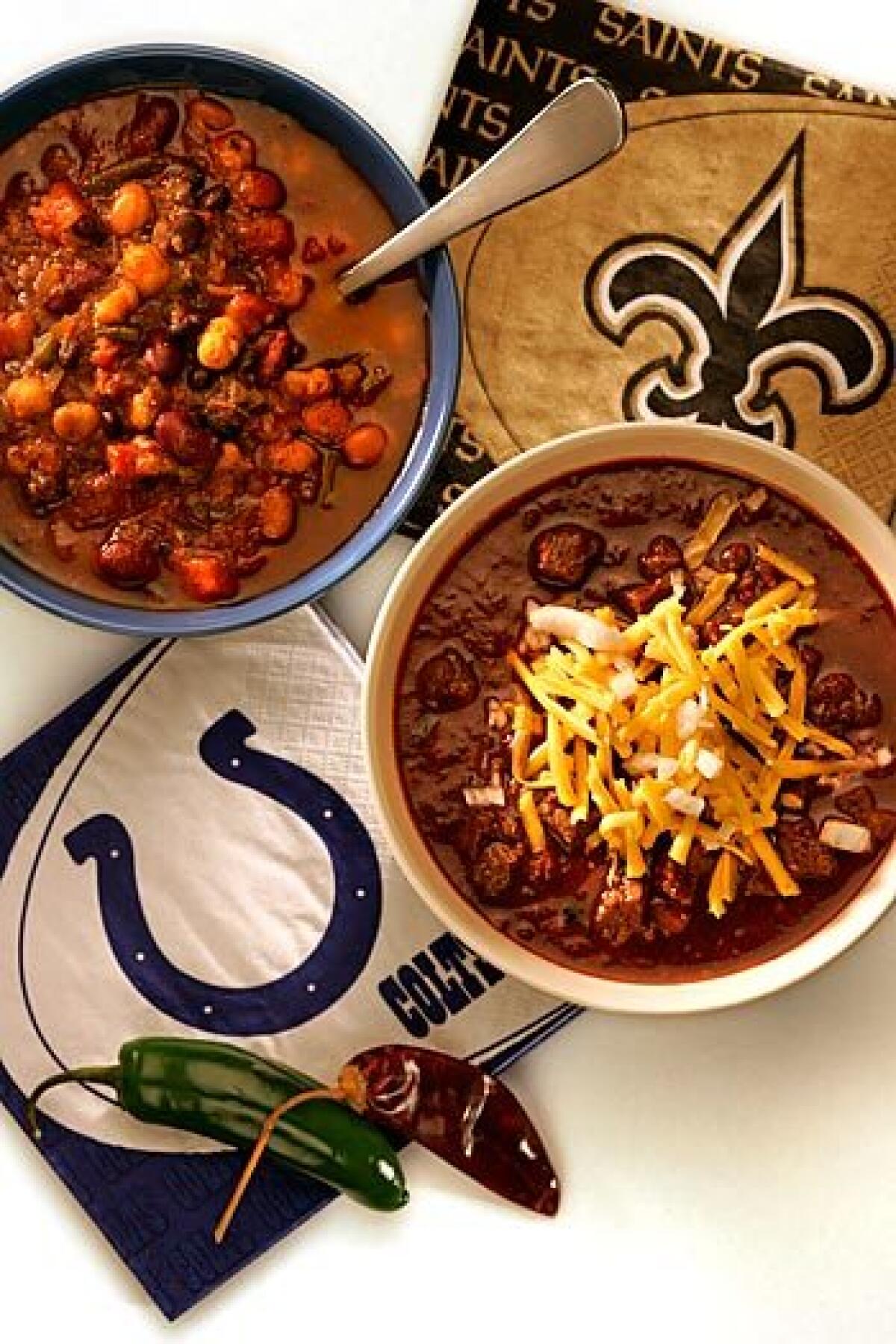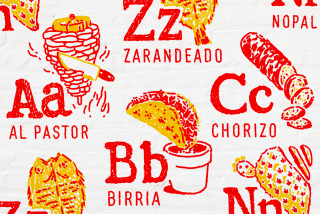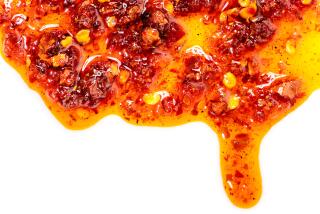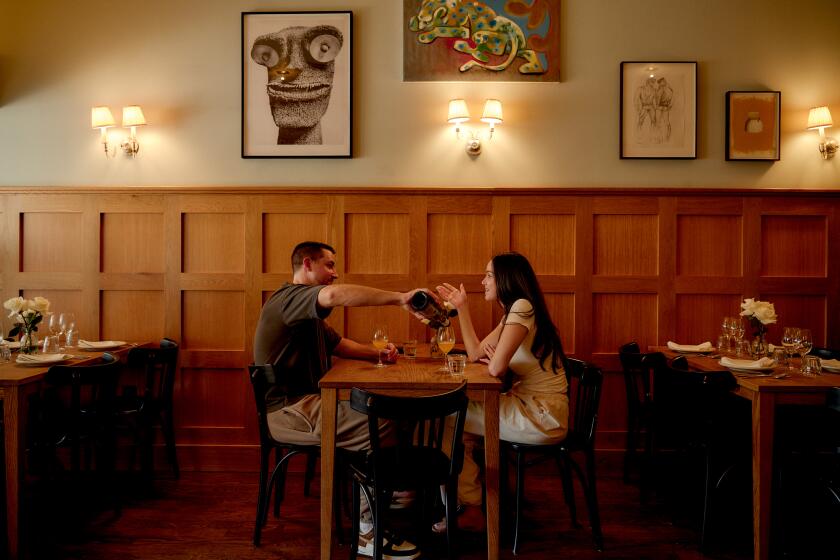Chili: a bowl of red-blooded American heaven

It’s been called both a “bowl of blessedness” and the “soup of the Devil,” and it’s the stuff of legend.
Frank and Jesse James reputedly downed a few bowls before pulling some of their heists -- and supposedly spared one town because of it. O. Henry spun a short story around it, and Will Rogers allegedly judged a town by its quality. It’s said Eleanor Roosevelt tried -- without success -- to get the secrets of one recipe, and that Lyndon B. Johnson remarked that the kind concocted outside his home state of Texas was “usually a weak, apologetic imitation of the real thing.” Not even Elizabeth Taylor was immune -- she had whole quarts packed in dry ice and shipped to Rome while she was filming “Cleopatra.”
I’m talking about chili, and I’ve been a devotee of the stuff for years now. There’s nothing better when you’re entertaining a crowd. And I don’t know about you, but I’ll be hosting a little football party on Sunday, and I plan to fix a big pot the day before. All I have to do is let it reheat while I entertain and watch the game and, voilà! Dinner is served. No stress.
Chili is a wonderfully simple, no-fuss dish. Meat, generally a somewhat tough cut of beef or pork, is spiced with chiles and stewed -- slowly -- with a few choice ingredients. The results are magical: a richly flavored dish (neither soup nor stew, chili is in a category all its own) that only gets better with time. Fix it a day or two ahead, cook it slowly, then let it sit awhile before serving, giving it proper time to mature and develop. A good chili ages like a fine wine.
That’s not to say chili is without its drama. Some people have an almost religious zeal about their chili -- and any deviation from the one true recipe is heretical. Still, the variations are endless. From the classic Texas beef-lover’s “bowl of red” to a New Mexican “bowl of green,” it’s a dish that’s arguably been adopted in some way by every state in the Union.
There are all-meat and all-bean varieties, as well as recipes for white chili, “Yankee” chili, wild game, turkey and even seafood chilies. Some chilies are proudly rated for their heat (“four-alarm,” “code red”). There are chili societies -- the Chili Appreciation Society International (CASI) and the International Chili Society (ICS) -- and chili cookoffs -- the CASI has held its annual event in Terlingua, Texas, since 1967.
And then there’s Cincinnati-style -- as if the chili alone is not enough, this may be served “five-ways” with, count ‘em: spaghetti, chili, beans, chopped onion and shredded cheese. Since we’re a nation united by variety, move over apple pie -- chili is the true All-American dish.
Colorful history
The earliest chilies were probably borne out of necessity, using some of the oldest tricks in the book: Cooking tough meat until tender and spicing it so it tastes good.
According to the legendary chili historian Frank X. Tolbert, some of the earliest chilies evolved on the trails, from dried beef packed with fat, seasoned with salt and spiced with dried chili peppers. Historian Everett DeGolyer called it a “pemmican of the Southwest.”
Eventually, in the 1880s, chili moved to town, as brightly dressed “chili queens” set up their stands at dusk in San Antonio, their colorful lamps leading customers to the wonderful smells wafting from chili that had been simmering all day.
The ICS speculates that, in competing with each other, these chili queens are probably responsible for improving chili and bringing it closer to what we know today.
This classic Texas bowl of red, or something like it, is my personal favorite recipe. This is a meat-lover’s chili -- no beans allowed.
I start with dried whole chiles, which I stem, seed and rehydrate. Sure, you can use packaged ground chile, but there will be a night and day difference in flavor.
Like all ground spices, chile powder can oxidize and lose intensity as it sits, making for hollow flavor. Dried whole chiles are rich with flavor and not too much work if you’re passionate about the end product.
Meat versus beans
I trim and cube several pounds of chuck roast. You don’t have to go for a high-priced cut; choose a cheaper piece that is tough and has a lot of internal fat for the best flavor. You could grind it, but I prefer cubes for their texture and appearance.
Render a pound of bacon in a big heavy pot, preferably cast iron. Leave a little of the fat in the pot, and purée the fried bacon with the rehydrated chiles to make a paste to add to the sauce. Pork is not usually found in Texas red chili, but the bacon helps thicken the sauce and lends so much flavor.
Stew the chili with onion, garlic and fresh-roasted chiles. I also add tomatoes -- that’s discouraged in certain schools too, but the acidity helps brighten the chili and focus all those flavors. And I throw in a beer -- a good dark stout -- to lift the flavors a little more.
Cook the chili at a low simmer until the meat is tender, about two hours. It’s great served right away, but like most soups and stews, it improves overnight in the fridge.
If you like to add beans, go ahead -- this is your chili. But throw them in toward the end; you don’t want to overcook them or they’ll turn to mush.
On the other hand, a bean-based chili can be surprisingly rich and full-flavored as well. I sometimes like to make a mixed-bean chili with hominy. It’s a colorful dish with a ton of flavor, rich and hearty. And no one would know it’s vegetarian unless you mentioned it.
Or you could take the chili method down a different path entirely. My lentil chili draws from a North African inspiration, using Merguez sausage and harissa (a hot, North African chili paste) for flavor. I balance the heat with fresh ginger, lemon, cinnamon and turmeric, and finish the chili with chopped fresh parsley and a sprinkling of cilantro. The flavors kind of explode in the mouth -- bright, fresh notes balanced with subtle but intense heat.
It’s not traditional, but it’s good. And whatever your preferences, at the end of the day, it’s all about good chili, whether you’re from Coleman, Texas (reportedly Will Roger’s favorite chili town), or Fort Worth (that little town supposedly spared by the James boys).
As Pat Garrett, famous for killing Billy the Kid, supposedly once said of the outlaw, “Anyone that eats chili can’t be all bad.”
More to Read
Eat your way across L.A.
Get our weekly Tasting Notes newsletter for reviews, news and more.
You may occasionally receive promotional content from the Los Angeles Times.











